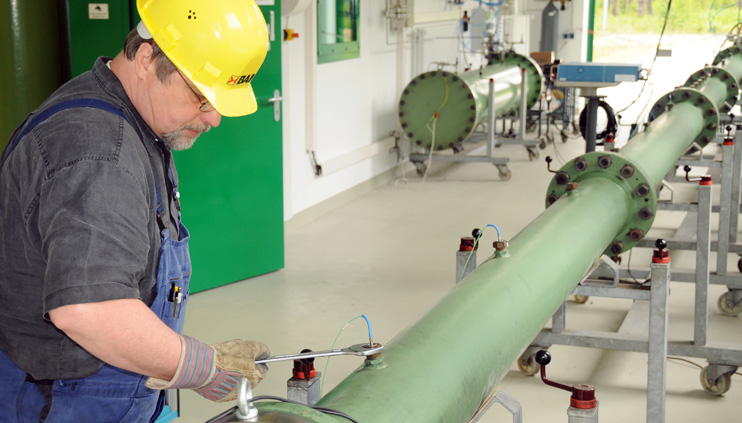
A BAM employee prepares a pipe for a gas test explosion.
Source: BAM
When the wind is blowing and the sun is shining, electricity production from renewable energy runs at full capacity. By 2020, at least a third of Germany's electricity is to be generated from renewable sources.
But where will the energy go when the grid is saturated? Currently, producers have to sell their electricity cheaply.And when the wind drops and it is cloudy, conventional power stations jump in. Being able to store excess electricity is, therefore, a central challenge of the energy transition. BAM is researching a solution for this task.
The gas grid is a giant sponge
There is a giant storage system in the ground – the gas grid. It can act like a sponge to absorb large quantities of hydrogen, which is produced from renewable energy sources using electrolysis. During electricity shortages the stored energy could either be re-converted into electricity in gas power stations or used in normal gas circulation, i.e. for heating systems and gas cookers. The process is called Power to Gas (P2G). According to statements by the German Energy Agency (dena) it could be economically viable as soon as 2022.
Despite a number of pilot projects, such as those in Falkenhagen in Brandenburg and in Prenzlau-Dauertheil, a critical question still needs to be answered: is it safe to add artificially created hydrogen into the normal gas grid?
Is there a risk of explosion?
"The natural gas grid cannot explode," states Dr. Volkmar Schröder, Head of BAM's Explosion Protection Gases and Dusts Division. He is researching the material properties of various gases, known as the safety-related parameters. An explosion requires a mixture of gas and air. At most this could occur above the ground if gas leaked from a P2G plant and caught fire, or perhaps during repair works if air got into the gas grid.
To minimise the risk of explosion, there are strict rules prescribed for operations, including safety zones around the plants. But which proportion of gas in the air could cause an explosion? Is an electrostatic discharge sufficient for ignition or is a spark required? And what level of pressure occurs during an explosion? BAM is addressing these questions.
BAM informs consumers
Dr. Schröder and his team are researching the safety-related parameters of gas mixtures with different compositions and documenting their results in the "CHEMSAFE®" database. Users from industry, trade, craft and the authorities can use it to find out about the risks of fire and explosion of gases during processing, bottling, transportation or storage.
Schröder's conclusion for natural gas is that "the safety-related parameters of natural gas do not change significantly within a mixture containing up to 10 percent hydrogen." This means that P2G technology can be used with existing systems and safety procedures with only minimal changes, and that no additional high investment costs are necessary. BAM's findings on this matter are also important for manufacturers of gas warning devices, who will have to adapt their products to suit the revised gas properties.
In total, P2G technology allows regenerative energy to be stored in the natural gas grid in the realm of terawatt-hours. Volkmar Schröder believes that this will also secure Germany's storage requirements in the long term.


